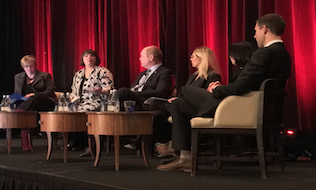
While financial literacy programs have become more prevalent in recent years, what can they do to ensure they have the maximum impact?
“Financial literacy, while important, is not the key to unlocking financial well-being,” said Lisa Callaghan, vice-president for strategy, marketing and communications at Manulife Financial Corp., during a panel discussion at the Benefits & Pension Summit in Toronto on Monday.
Read: Four steps to building a successful financial wellness program
Employers have a key role to play in dealing with the issue because employees are bringing their troubles to work in the form of both physical and psychological difficulties, noted Stacy Yanchuk Oleksy, director of education and community awareness at the Credit Counselling Society, during the panel discussion.
“If you’ve got anxiety or depression, it isn’t getting better; in fact, it’s exacerbating it if you’re worried about your credit card,” she said.
“We feel stupid, embarrassed and, even worse, we feel ashamed,” she added. “And Canadians are suffering in silence.”
Much of the embarrassment stems from the fact that many Canadians lack even the basic language to discuss the issues because they don’t learn about financial topics in school and then find themselves thrust into a world they’re not ready to deal with, said Oleksy.
Read: Sounding Board: Mental-health approach key to helping employees tackle financial issues
“Maybe I don’t even show up [to work] because my headache is that bad. Or if I do show up, I’m a zombie,” she said of some of the impacts of financial stress.
Financial education is essentially preventative care for potential psychological difficulties, said Francois Joseph Poirier, vice-president of business development at Desjardins Insurance, during the session. “As an employer, you realize that an employee has a financial problem when it turns into a psychological problem,” he said.
Read: Three tips for improving employees’ pension literacy
In building programs with a preventive focus, employers need to be aware of their employees’ learning styles, said Adrianne Sullivan-Campeau, vice-president of human resources at Allstate Insurance Co. of Canada.
As well, programs should recognize the link between physical and financial wellness, she added. At her company, for example, a recent smoking-cessation clinic emphasized the financial benefit of kicking the habit.
Employers also need to address the fact that the majority of employees don’t even know they have access to an employee assistance program or how to use it, said Barb Veder, vice-president of clinical services and research lead on employee support solutions at Morneau Shepell Ltd.
Oleksy agreed, noting employers should familiarize themselves with what actually happens when an employee accesses the employee assistance program.
Read: What you don’t know about your employee assistance program
Technology is likely to play a larger part in employee assistance programs, noted Ryan Weiss, assistant vice-president of group customer market development at Great-West Life Assurance Co. For example, benefits providers may start harnessing artificial intelligence, perhaps with therapy through a chatbot, he said.
Overall, Weiss said financial wellness programs need to help Canadians get better at setting goals. “It sounds a bit paternalistic, but I think we’re paternalistic about carpal tunnel and back pain, so why not this?” he said.
